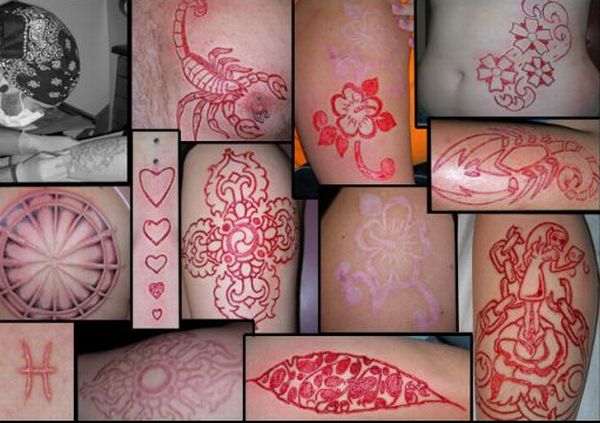Scarification is nothing but etching, scratching, burning or cutting designs superficially on the skin to make some kind of permanent body modifications. Though there is a risk of infection, many people still indulge in scarification due to various reasons. Many people do it just to enhance their looks. While some of them do it for religious purposes or standing out in the crowd. In certain tribes, women who are ready and willing to bear children do scarring on their abdomen. This denotes that they are mature enough to bear children.

How it is done
Scarification is done by branding or cutting to create designs. When it is done by cutting, sections of the skin are removed with a sharp and surgical knife or blade. The artist who does this also uses tiny medical scalpels that are disposable. Using the same blade for different persons is not recommended as it can cause infections. When scarification is done by branding, heat is used as the cauterization tool. Heat is used to remove the skin and create a design you need. As the burns heal, it will turn into the scar on the skin. Scarification is considered to be a form of controlled injury that should be performed only by professionals.
Growing popularity
Scarification is getting popular recently. The process and results spurred a special kind of nostalgia for forming different kind of society. The industrial consumerists today are getting attracted and interested to the primitive societies and their ways. There is some kind of fascination that is drawing them toward the practice. Many people are getting these done in order to look attractive and be different from others. Some of them even take it as a way of expressing their artistic refinement and taste.
Ancient roots
The painful body modification movement has been an ancient practice. During 1870s, the Maori men living in New Zealand had etched tattoos all over their face. Various patterns were chiseled on their skin to make ridges and groves. They looked fierce but attracted women. None of the designs was similar. So each man was different from the other and it served as a means of identity as well. Other earlier forms of scarification included rubbing ash into the cuts to make blackened scars.
Traditional importance
As already mentioned, the practice of scarification is very popular among various tribes. Men did scarring in order to have an identity of their own and to attract women.
1. It is considered as an initiation right for the young men in Papua New Guinea. The back, chest and buttocks are cut using a bamboo to test their self-discipline and strength. The scars that result represent the teeth marks of a crocodile that was believed to swallow the man during the ceremony.
2. In Ethiopia, the scars are seen on men’s chest. The scars represent the killing of other tribal enemies. Women with scars are considered to be attractive.
3. In Australia, the Aboriginal people used scarification on the bellies, shoulders and chest of men. People who did not have these scars were not allowed to participate in the tribal activities.
Current trends and status
Experts believe that many people scarify simply to look different from others or follow a trend.
According to Victoria Pitts, a professor at the City University, New York, scarification has become very popular in the U.S. and Australia during the last 7-8 years. It was originally followed by lesbian and gay subcultures during the 1980s.
Vince Hemingson, a filmmaker, writer and a person who has studied about body modifications, believes that scarification is bloody and painful. He also believes that scarification happens in cultures where the people had skin with a lot of melanin making it very difficult to see the tattoos.
Pitts, on the other hand, argues that scarification makes people to be different from others just like people using other methods to beautify themselves using cosmetic surgery, Botox, etc.
Quellette, however, feels that scarification is not going to become as popular as tattooing because it has a bizarre stigma attached to it.




